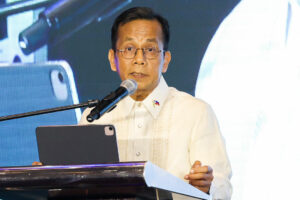THE Philippines’ income classification is not a primary consideration for prospective investors, the Department of Economy, Planning, and Development (DEPDev) said.
If the Philippines fails to meet its goal of graduating to upper middle-income status soon, this would not significantly dampen its investment prospects, it added.
“I don’t think that’s what investors are looking at. Investors are looking at your investment climate,” Economy Secretary Arsenio M. Balisacan told reporters on the sidelines of an event on Tuesday.
“They’re more concerned about how we address the constraints to investment, the ease of doing business, your economic fundamentals, the deficit, inflation. They don’t care about that particular metric,” he added.
The Philippines is currently classified as a lower middle-income country with a gross national income (GNI) per capita of $4,230 in 2023, according to the World Bank.
An economy is considered lower middle-income if GNI per capita is between $1,146 and $4,515, while upper middle-income countries are those with GNI per capita of $4,516 to $14,005.
“Of course, it’s good that we develop because GDP per capita or GNI per capita is an average overall measure of welfare. It doesn’t tell us about the distribution of the gains or the distribution of the output, but it provides a certain information.”
“If it’s growing fast, then it’s of course good, but where is that growth coming from? That’s even more important,” he added.
Mr. Balisacan said investors are more likely to consider information on growth sources, policy priorities, and incentives.
The Marcos administration is hoping to achieve upper middle-income status by 2026.
Mr. Balisacan has said that the Philippines is still on track to hit this target “barring major external shocks.”
“You have to employ innovation, you have to employ modern technology, you have to develop your workforce, educate your people, in other words, you upskill and reskill them so that they can be more productive.”
“That way you can continue to grow even as you already are out of those cheap traditional sources of growth,” he added.
The World Bank has projected that the Philippines is likely to reach the upper middle-income class tier by 2027.
“It’s a moving target, but the context again is when we were making the projection last year, the world economy was not as bad then. The tariff uncertainty, the trade uncertainty was not there at all. There was only a bit of that, but not to this extent,” Mr. Balisacan said.
“We were still counting on a robust global economy… For that reason, we projected 6-8% growth. Of course, now the situation is a bit different, but a slowdown of one year does not take away an ambition, a long-term vision.”
He said the Philippines can position itself to recover once external conditions improve.
“The biggest threat to a middle-income trap is complacency. If you become complacent, that’s when you get trapped into that middle-income status.”
The Philippines hosted the High-Level Conference of Middle-Income Countries, which culminated in the adoption of the Makati Declaration, which serves as a roadmap for middle-income economies to address challenges and accelerate sustainable development.
Over 100 countries fall under the middle-income classification, accounting for about 75% of the world’s population. They also account for about a third of global economic output.
“We recognize that middle-income countries experience frequent growth slowdowns and, if left unaddressed, this loss of economic dynamism can cause countries to get stuck in what is referred to as the ‘middle-income trap’,” according to the conference declaration.
It flagged persistent challenges middle-income countries face, such as high inequality, low growth, and persistent growth and unemployment, among others.
Since 2000, only 27 countries have graduated to high-income status from the middle-income tier.
“We note that current approaches to development cooperation result in most official financial flows to middle-income countries taking the form of loans rather than grants, including access to climate finance,” it said.
“We stress that middle-income countries have a significantly greater share of foreign liabilities among the developing countries arising from higher dependence on debt instruments.” — Luisa Maria Jacinta C. Jocson
